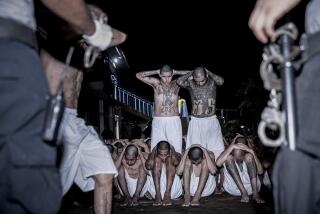Unaccompanied migrant youth in U.S. detention centers rises 50%
- Share via
Gang violence in Central America has led to a startling increase in the number of children who make the dangerous journey across the Mexican border alone in search of asylum in the United States, according to a report by the Women’s Refugee Commission, a nonprofit that advocates for displaced women and children.
The number of unaccompanied migrant children in U.S. detention centers grew nearly 50%, from 6,854 in fiscal 2011 to more than 10,000 in the nine-month period ended June 30, according to federal statistics cited in the report, titled “Forced From Home: The Lost Boys and Girls of Central America.” With three months left in the latest reporting period, the fiscal 2012 figures are expected to rise further.
Most of the growth came from three countries: El Salvador, with 68% more unaccompanied minors; Guatemala, with 72% more; and Honduras, with the number more than doubling, from 1,201 to 2,477. The number of Mexican children crossing the border alone fell in the same period.
In interviews conducted with 151 children in federal holding facilities, nearly 80% told researchers that violence was the main reason they set out for the U.S. by themselves, traveling with paid guides on buses or chancing the desert trek as stowaways on top of trains.
One 16-year-old from Honduras told the report’s authors that he was threatened with physical violence after refusing to be recruited by a gang. He could no longer attend school safely, so he came to the U.S. to continue his studies.
The children travel on their own because their parents are already in the U.S., because they are fleeing domestic violence or because the family cannot undertake the journey together, said advocates who work with them.
“What they said is, ‘If I stayed, I definitely would die.’ They knew it would be a dangerous journey, but at least there’s a chance,” said Michelle Brane¿, director of the Women’s Refugee Commission’s detention and asylum program.
U.S. Customs and Border Protection, along with the Department of Health and Human Services’ Office of Refugee Resettlement, were criticized in the report for operating substandard detention facilities. Officials from the two agencies were unavailable for comment.
The Federation for American Immigration Reform, an anti-immigration group, blamed the influx of Central American children on a new federal program granting a two-year reprieve from deportation to some young immigrants.
“The Obama administration has made it very clear — if you get your kids to the U.S. and keep them here for a while, they can stay,” said Ira Mehlman, a spokesman for the group. “That’s the unmistakable message he’s sent around the world. Not surprisingly, you have parents who say, ‘Let’s do that.’”
Other countries are responsible for ensuring the safety of their own citizens, Mehlman added. Asylum should be reserved for a select few cases, or “the potential is you could have billions of people qualifying for political asylum in the U.S.”
Most of the young border-crossers will end up going back to the countries they fled, immigrant advocates said.
The children have no right to a court-appointed attorney in asylum proceedings. Even with legal counsel, cases based on the threat of gang violence have proved difficult to win. Most successful cases have involved children who have lost their parents because of abandonment, abuse or neglect, said Judy London, directing attorney of the Immigrants’ Rights Project at the pro bono law firm Public Counsel.
“It’s all dependent on getting an experienced lawyer,” London said. “The vast majority aren’t going to get the legal representation they need, or they’re going to get it too late.”
Emergency “surge” shelters to house young migrants arriving without parents have been built, said the report.
The report likened conditions in the surge facilities, opened after October 2011 by the Office of Refugee Resettlement, to those in an emergency hurricane shelter. The children received basic medical care, four hours of school and some recreation but not the full slate of education and case management offered in regular detention centers.
Because the new centers sprung up so quickly, they often neglected to provide the “Know Your Rights” legal orientations that are standard in detention facilities, leaving the children clueless about their options, the report said.
The massive increase also resulted in detainees spending longer periods in temporary holding cells, nicknamed “freezers” operated by Customs and Border Protection. The children described the cells’ conditions to the report’s authors as having inadequate food and water and lights on 24 hours a day, and lacking blankets in frigid temperatures, showers and enough room to lie down.
More to Read
Sign up for Essential California
The most important California stories and recommendations in your inbox every morning.
You may occasionally receive promotional content from the Los Angeles Times.











